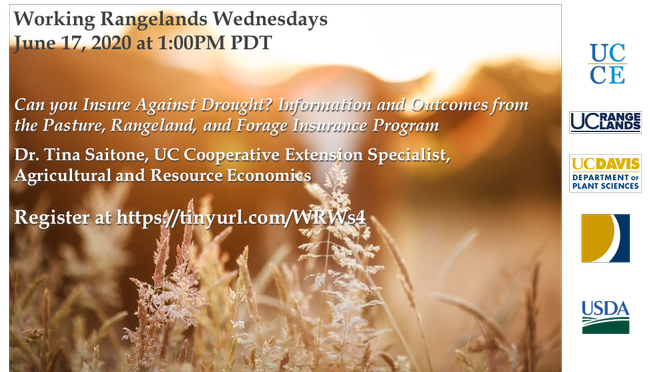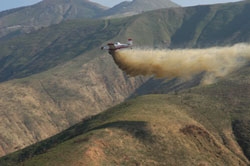Join us for our next webinar on Wednesday, June 17th at 1pm PDT, which will feature Dr. Tina Saitone, CE Specialist in Agricultural and Resource Economics, presenting "Can you Insure Against Drought? Information and Outcomes from the Pasture, Rangeland, and Forage Insurance Program".
Register at https://tinyurl.com/WRWs4
(we will email registrants a Zoom meeting link morning of the webinar)
Working Rangelands Wednesdays is a bi-weekly webinar series where we explore topics around rangeland agriculture in California and across the West.
You can view previous Working Rangelands Wednesdays sessions on the UC Rangelands YouTube channel.
For questions, please contact Grace Woodmansee at gwoodmansee@ucdavis.edu.

Working Rangelands Tina Saitone
Posted on
Friday, June 12, 2020 at
2:38 PM
Focus Area Tags: Agriculture
Many factors make weed management on federal public lands an interesting challenge.
In September I was invited to join one of the Sierra National Forest Rangeland Management Specialists to explore a medusahead infestation in one of the grazing allotments she manages. The infested meadow used to be...
Posted on
Monday, October 28, 2019 at
8:57 AM
Focus Area Tags: Natural Resources, Pest Management
Below is a an article released by the US Forest Service Rocky Mountain Research Station. It is worth a read by anyone interested in rangelands and open space and the impacts from urban development. Especially chilling for Californians!
Homes on the Range: Helping to Understand Residential Development of U.S. Rangelands
Download PDFSee ALL Science You Can Use
A Changing Landscape

Rangelands on the Edge quantifies and maps aspects of rangeland conversion, including watershed fragmentation. The darkest red color on the map represents the most fragmented rangeland watersheds.
When the words to the classic folk song “Home on the Range” were written in 1872, U.S.rangelands were much more extensive than they are today. Over the past three centuries in the coterminous United States, one-thirdofrangelands — once covering a billion acres — have been modified or converted to other land uses. This shift is projected to continue, because privatelyownedrangelands, which are the most likely to be converted to other uses, represent more than 60 percent ofAmerica'srangelands.
Residential Development and Spatial Analysis
Residential development has had a particularly significant impact on rangeland ecosystems, including wildlife habitat reduction and fragmentation, altered hydrology and water quality, and decreased availability of natural and recreational goods and services. It's a growing issue, as an additional 5.6 million acres of U.S. rangelands are expected to make way for residential development in the next two decades or so, with more than 1 million of those acres in California and Texas alone.
To better understand where and how residential development is likely to affect U.S. rangelands, a team of scientists is collaborating on an ongoing project known as Rangelands on the Edge, which estimates past and projected rangeland conversion while evaluating landscape-level rangeland threats. It's similar to another Forest Service project called Forests on the Edge, which also has the key goals of increasing awareness of ecosystem values and challenges while creating tools for strategic planning.
Where to Find the Findings
People can find a report based on this project, entitled “Rangelands on the Edge: Quantifying the Modification, Fragmentation, and Future Residential Development of U.S. Rangelands.” The lead author, a research ecologist for the Rocky Mountain Research Station named Matt Reeves, explains, “Landscape change is inevitable and there will be tradeoffs. This research provides a springboard for having discussions about what we want the future to look like.”

Much of the decline in rangeland area is due to land use changes associated with exurban development, agriculture, and grazing (Photo by Carrie MacLaren, courtesy of 1000 Friends of Oregon).
According to the spatial analysis described in the report, continued rangeland conversion will affect some areas more than others. California and Texas are likely to be most affected, followed by Florida, Arizona, and Colorado. States with less dense human populations, such as Wyoming, Montana, and North Dakota, will be impacted less although localized changes may be significant. Also, further rangeland conversion is most likely around urban areas. The report also indicates that residential development impacts are reduced by concentrating housing in specific areas while setting aside and managing open spaces through conservation easements and land purchases.
KEY FINDINGS
- Through a project called Rangelands on the Edge, RMRS scientists and collaborators are studying past, current, and projected changes to rangelands related to residential development in the conterminous United States.
- A recently published report on the project includes maps and analysis of variables such as housing density, road and soil characteristics, topography, proximity to population centers, and land cover, use, and ownership.
- This information can help refine planning and development decisions related to residential locations, land cover, highway placement, watershed management, and minimizing the effects of rangeland fragmentation.
- While past U.S. rangeland conversion has been driven by agricultural development, especially in the Great Plains region, the greatest projected residential development is in the arid Southwest and California, especially near urban areas. Of more than 5.3 million acres of projected residential development through 2030, nearly 2.5 million acres are in California and Texas. Certain smaller urban centers such as Bozeman, Montana, will also continue to experience rapid changes.
- Scientists are available to help interpret findings on a local level. Additional information can be obtained by contacting Matt Reeves at matt.c.reeves@usda.gov.
Planning for Wildfire, Wildlife Management, and More
Reeves also describes an issue he's seen in western Montana: “Here in the Bitterroot Valley, the human population is expanding while agricultural and rangeland resources are being diminished. As a result, there's been an increase in motor vehicle collisions with elk as they're squeezed into corridors that might require them to cross a road. Our research can help develop travel management plans that consider wildlife corridors and include carefully placed overpasses, underpasses or fences.”
Reeves hopes the work will enable more informed decision-making related to U.S. rangeland development. He explains, “While there's some urgency about this issue, there's also opportunity. We believe that this research is the first step in more localized research, which will help bring people to the table.”
Further Reading
Reeves, Matthew C.; Krebs, Michael; Leinwand, Ian; Theobald, David M.; Mitchell, John E. 2018. Rangelands on the Edge: Quantifying the modification, fragmentation, and future residential development of U.S. rangelands. RMRS-GTR-382. Fort Collins, Colorado: USDA Forest Service, Rocky Mountain Research Station.
Posted on
Thursday, May 30, 2019 at
2:57 PM
Focus Area Tags: Environment, Natural Resources
We have a rare opportunity for aerial seeding of rangeland as the window for planting is closing in about 30 days. After about December 15th our soil temps become too cold for good germination. Diane Curry, Interim Agricultural Commissioner, was contacted by Gibson Oster a crop duster pilot from the Fresno area. Gibson has family in Redwood Valley and he will be coming to the area to fly on seed to rangeland affected by the fire. Currently, he has been contacted by several growers and will be seeding 2400 acres. If anyone else wants to have reseeding done they should contact Gibson at 707-489-3434.
The current cost is $9/acre for 10 pounds/acre seeding rate and $10/acre for 20 pounds/acre seeding rate. If more landowners participate with more acres the price may go down. Gibson plans on being here on the Sunday after Thanksgiving which is November 26, 2017. Diane, Devon (Farm Bureau), Katie Delbar (FSA) and I are working together to get the word out not just the ranchers who have been affected by the fire, but also any rancher who would like to take advantage of the plane being in the area to get some seeding done. Diane was told that Gibson said that he would help to source seed. Feel free to share this information with anyone you think might want to be involved.
Usually the goal for a cattle, sheep or goat livestock operation is to maximize high quality forage production. Typically on the North Coast, a 50:50 mix of annual grasses and legumes are recommended and seeded at 20 to 25 lbs per acre. The grasses are usually annual ryegrass, brome and fescue. The annual legume is subterranean clover. In areas of less steep topography and good soils, Berber orchardgrass, a perennial, may be substituted for part of the grass mixture. Perennials extend the green season providing better forage and enhance carbon storage. Many, however, don't compete well with annuals and have difficulty surviving our hot dry summers. A recent paper in California Agriculture was just published on some other promising forage perennials. The study was done in the Sierra foothills and a few of those mentioned have been tested here. The link to the current issue is http://ucanr.edu/repository/fileAccessPublic.cfm?calag=fullissues/CAv071n04.pdf&url_attachment=N. The range seeding paper starts on page 239.
For those interested in using California native grasses and forbs check out the following publication at http://ucanr.edu/sites/BayAreaRangeland/files/267610.pdf. Be aware that seed sources for natives will often cost more than 10 times the typical forage species. Also some are toxic to livestock or are not great forage species.
Posted on
Thursday, November 16, 2017 at
4:59 PM
The University of California Division of Agriculture and Natural Resources is seeking a Cooperative Extension Advisor who will serve UCCE Placer-Nevada and Sutter-Yuba Counties with headquarters in Auburn, CA. Please help spread the word about this position that will focus on integrating livestock, natural resources, food systems and economics.
A minimum of a master's degree is required, though other advanced degrees are encouraged, in disciplines such as animal science, rangeland management or other closely related fields. Incumbent is required to become a Certified Rangeland Manager within five years of date of hire; see http://casrm.rangelands.org/HTML/certified.html.
Excellent written, oral, and interpersonal communication skills are required. The ability to build partnerships and to work with multidisciplinary teams to address production and environmental challenges is required. Experience in applied research and extension is preferred.
SUBMIT BY date for full consideration is Monday February 27, 2017. It is position #AP16-20.
See the web link http://ucanr.edu/Jobs/Jobs_990/?jobnum=1123 for access to the full position announcement and required academic application form.
Questions about this recruitment may be directed to Karen Ellsworth: Phone: 530 750-1284; kaellsworth@ucanr.edu.
Posted on
Friday, February 10, 2017 at
2:51 PM



